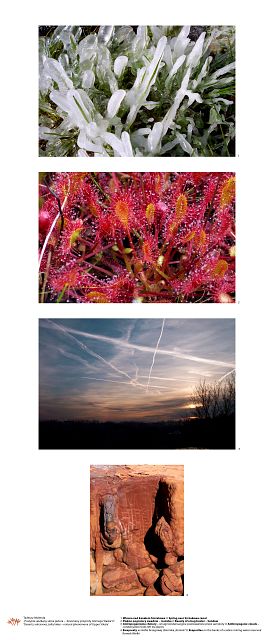
Description popularizing the research project
So far has the man gone in curving and shaping the face of the Earth. He dug up deep valleys searching ores and build high hills of extracted rocks. He drained huge areas and linked rivers with canals. He filled artificial reservoirs with salty water from coal mines. All the brutal changes are stoically accepted by the Nature. Then patiently it starts, itself or with help from a man, rebuilding natural connections. Right now just in front of us there is a fascinating microevolution in progress. To date we could observe ecosystem from the moment of their birth only after catastrophic volcano eruptions. Today everybody can watch development of ecosystems in real not on a computer screen or in laboratory. A salty lake in the upper reaches of Vistula really became a sanctuary of rare wading birds and plants. A canal of a sand pit in Jaworzno is really a place full of trouts and crayfish. Biscutella laevigata, a rare plant which can be found in West Tatra Mountains really grows on a slag heap in Bolesław as it likes soil rich in zinc. Indeed the Nature has scattered a lot of jewels across the region which does not seem to deserve them.
Establishing protected areas in such places is not a sign of arrogance and approval of human activities. It is simply necessary to let the life adapt to the new conditions. Otherwise the attempts the Nature has made will be wasted and their results will disappear in thin air just like vapour trails left by jet planes. But unlike the ephemeral trails the slag heaps, gravel pits, and artificial lakes will remain in the Silesian landscape.
Abstract
Economic human activity leads to essential changes in natural environment. These changes are connected mainly with the development of farming systems and urban - industrial units. In many cases the creation of completely new, not existing before anthropogenic environments takes place. The term "anthropogenic environment" has not been defined univocally so far, but it does not mean that it isn't used in literature. In this work I suggest introducing a following definition of "anthropogenic environment":
Anthropogenic environment - an area within which as a result of human activity a primary ecosystem has been destroyed. Instead new habitats have appeared. The development of biocenoses might be a result of spontaneous succession (primary or secondary) or it might be supported by a human. Newly created ecosystems may function unaided or they may be maintained due to the inflow of the matter and energy from outer sources, such as city or ploughland ecosystems. From their beginning they start to undergo natural morphogenic and biological processes. The most typical anthropogenic environments are stone-pits, sand-pits, gravel-pits, waste-tips as well as artificial water reservoirs and canals.
Numerous researches show that some of the anthropogenic environments are characterized by a high biotic diversity. In many cases they are also habitats of very rare and protected plant and animal species. Sometimes, biotic diversity of anthropogenic environments is not so large but there are species which have their only habitats in a certain region or even a country there. It can be exemplified by Biscutella laevigata which can be observed within the area after the exploitation of zinc and lead ores in Bolesławiec near Olkusz. It is its only habitat in Poland apart from the Tatry Mountains. The above-mentioned examples prove that some of anthropogenic environments are so valuable as far as nature is concerned that they be protected. It is especially important in urban-industrial areas where natural ecosystems have been completely destroyed.
These photos present selected anthropogenic environments within the area of Upper Silesia. Apart from landscape photos showing anthropogenic environments, macro photos have been presented. They show specific forms or selected organism species existing within these areas.

